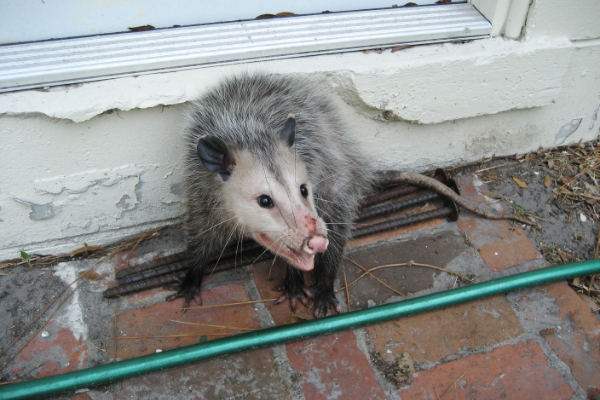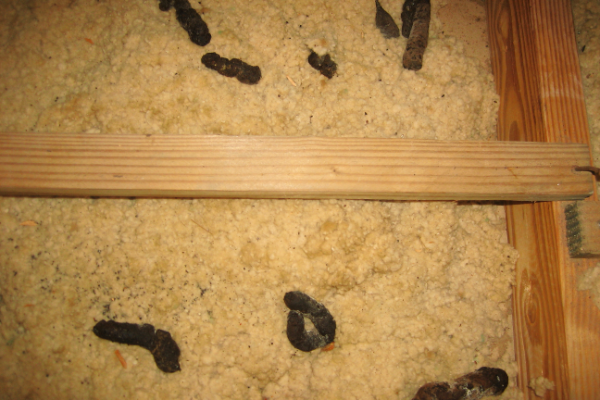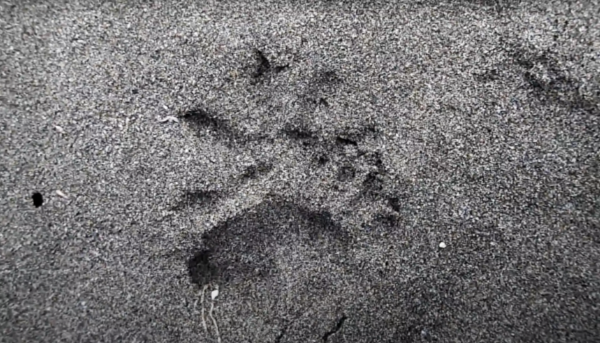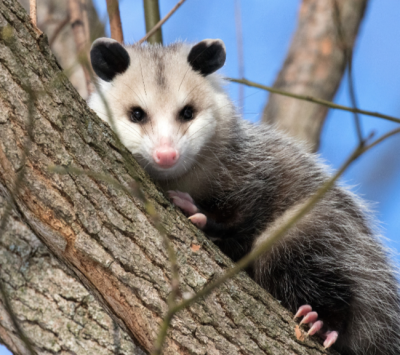Identification
Opossum

Sounds
Opossums are generally not very noisy animals. However, when they are threatened, the male opossums will often emit a deep growling sound. The pitch of this growl increases as his situation becomes more desperate. When alone and stressed, young opossums will often attempt to signal their mother to come and find them by producing a considerable sneezing sound. When searching for a mate, male opossums make a clicking sound (like a smacking noise) in the side of their mouth. In return, females will repeat this clicking sound.
Beyond these particular circumstances, opossums tend to be very quiet. The sounds will usually be heard in the night since opossums are nocturnal. Because these sounds are emitted only in response to or to gain the attention of others, it usually means that more than one opossum is present. Sometimes hissing and clicking sounds may be heard under porches or in garages, for the reasons given above. Opossums have also been known to make rumbling sounds. When foraging for food, their movements often create a rustling sound as they pass through grasses and vegetation.
Opossum Droppings:

The appearance of opossum droppings depends on the diet of that specific opossum. Therefore, since their diet varies widely, so does the shape and size of their feces. However, there is some uniformity, in that the droppings are usually pointy at one end and between one and three inches in length. Often they are curled up. They tend to be smooth on the sides. Usually, they are brown in color, though they often have white or yellow-colored mold growing along the outer sides. Sometimes, however, opossum droppings may look very similar to cat droppings. Some samples have shown coarse droppings filled with undigested seeds and plant matter, black in color.
Usually, opossums choose areas protected by leaf cover, often near their trails, to defecate in. Opossum droppings can carry a variety of dangerous bacteria, and therefore should be handled with caution. They have been found containing Equine Protozoal Myoleoncephalitis, a very infectious disease that can seriously damage the central nervous system of horses.
Opossum Tracks:

Opossum tracks are very distinctive because of the shape of the animal’s feet and the way that it walks. The prints display four feet of widely spread toes, which often, therefore, resemble a “little starfish”. Each print has a diameter of roughly two inches and displays five toes and a thumb that produces a print somewhat similar to that of a human thumb since both are opposable. Because of this, the prints produced by the back feet of opossums sometimes appear similar to the handprint of a human child. The front feet are smaller than the back feet. The nails, unlike in the tracks of other small animals, don’t tend to appear in the prints.
As well as distinctive prints, opossums also have a distinct way of moving, almost like waddling, which shows itself in the patterns of their tracks. As an opossum ages, this waddling becomes more and more pronounced. When opossums walk, they are also able to keep their tails raised in the air, resulting in some trails having tail marks and others with none. When the tail appears, it usually produces a zig-zag pattern on the ground. The tail tracks are much more visible in the snow since the opossum is unable to raise it high enough above the snow cover. Because opossums walk in this waddling, shuffling motion, their prints tend to overlap. Often, for example, they may step with their back feet into the already-made tracks produced by their front feet, producing shapes featuring the “little starfish” at the front, covered at the back by a print from the rear foot, which is slightly longer.
It is also possible to identify that the tracks belong to an opossum by finding opossum droppings left in or near the tracks. These tracks usually appear, on human property, along railings, trees, and other structures that the opossum may use while searching for food. Because they are very good climbers they are often found on ledges, having climbed up walls.
Opossum Damage
Opossums are considered pests by some because they can create problems in indoor spaces such as garages, sheds, and attics by creating very messy nests. In the process of gaining access to these interior spaces, they often tear up tube systems. They bring a lot of food to the nests, and pieces of food are often left around to grow moldy. Sometimes opossums also build their dens in roofs. They may scatter garbage both inside and outside.
If living in the attic, they may use their sharp teeth to destroy air ducts and other surrounding materials, which require urgent replacement. They can also chew into electric wires and insulators around the attic, which can lead to serious fire hazards and even burn down the property. If they get stuck in a certain place, they may even chew into the wall. In the space in which they live, they will leave a large number of droppings which create a strong, unpleasant smell. Thus their presence can be discerned by this unpleasant odor. This is considered the most serious type of damage since the droppings can also cause diseases and are attractive to parasites. They also encourage bacterial growth. In addition, when opossums urinate they can leave serious stains behind on the ceiling and across the attic. Since opossums can become infested with fleas and mites, they may transmit these to the indoor environment.
They can also cause serious damage to garden areas while they are digging for food, and injure various plants by feeding on the fruits. In some cases, they have also been known to destroy poultry. They may also travel through the house to eat any food left for pets. Because opossums don’t live for a very long time, if they create a nest within a house, it is highly likely that many of them will die there. Opossum bodies disintegrate very quickly and smell extremely bad, which then attracts more bacterial growth and flies.

